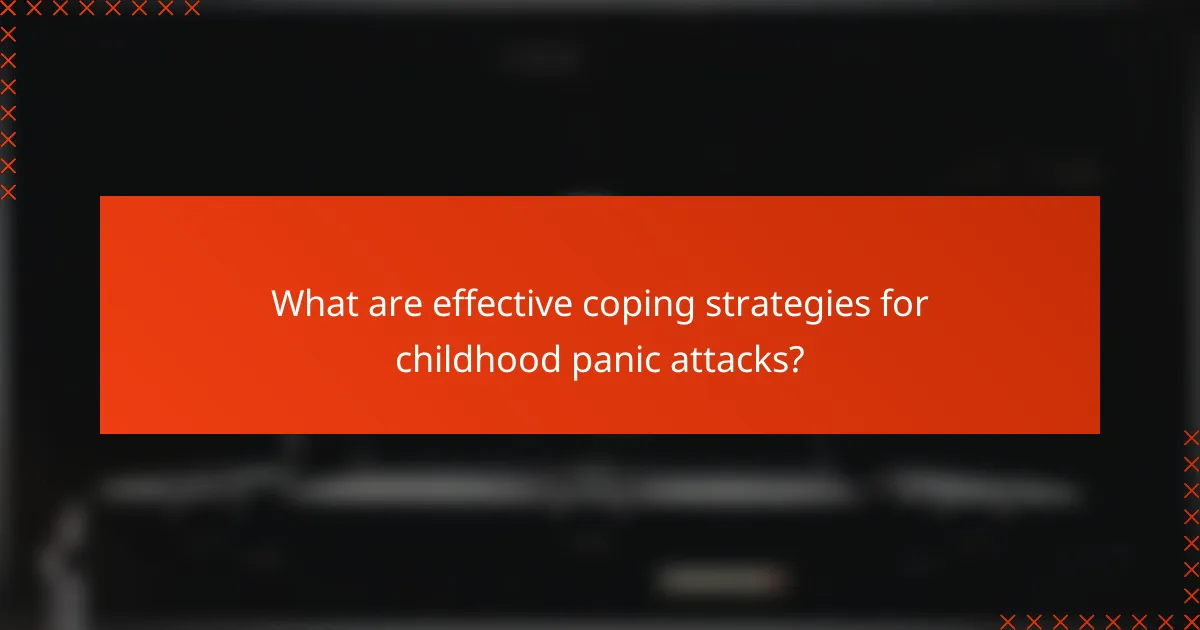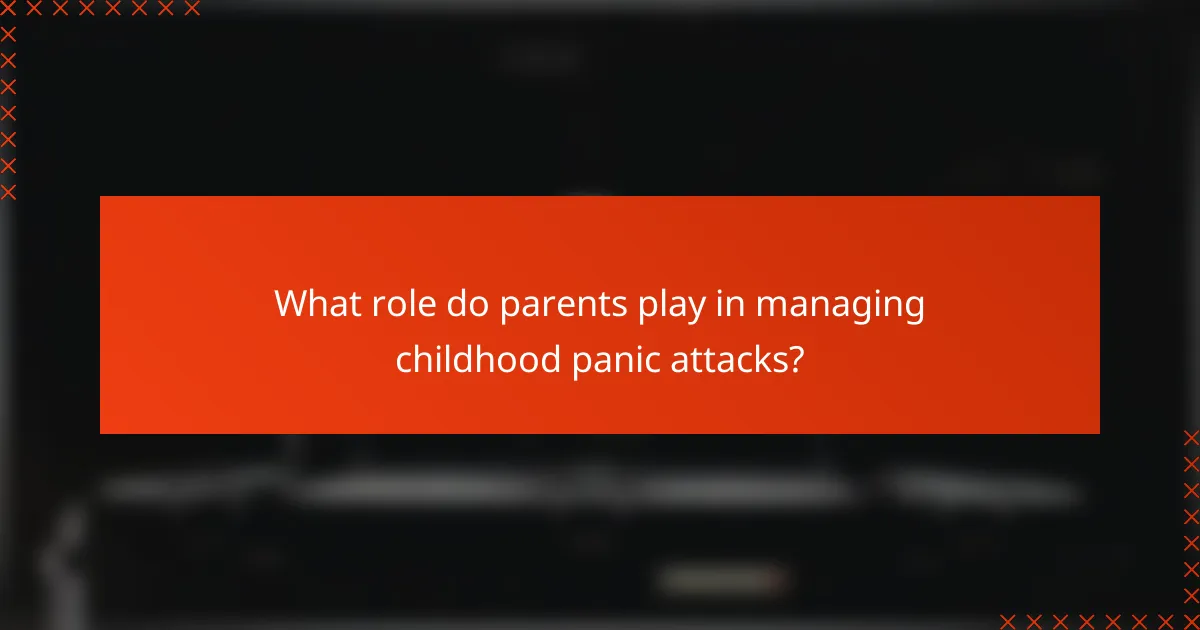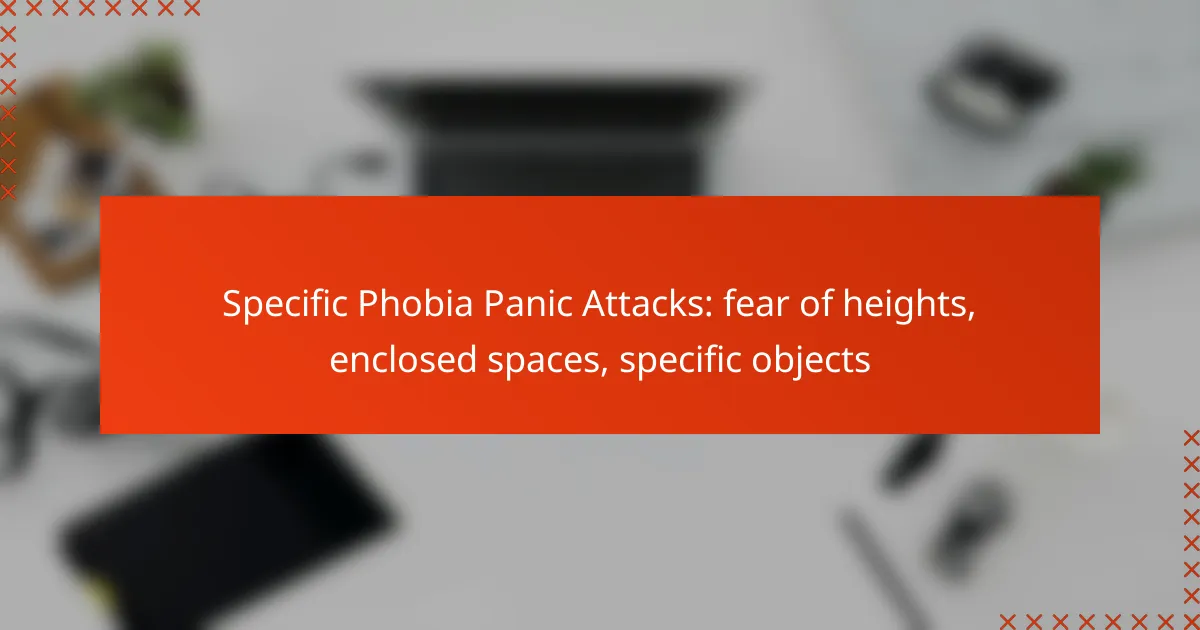Childhood panic attacks can be influenced by a variety of developmental factors, including genetic predispositions and environmental stressors. Parental influence is critical, as parents’ responses to anxiety can shape their child’s coping strategies and emotional resilience. Implementing effective coping strategies, such as mindfulness and breathing exercises, can empower children to manage their anxiety and mitigate the impact of panic attacks.

What are effective coping strategies for childhood panic attacks?
Effective coping strategies for childhood panic attacks include mindfulness techniques, breathing exercises, parental support systems, therapeutic interventions, and school-based programs. These approaches help children manage anxiety and reduce the frequency and intensity of panic attacks.
Mindfulness techniques
Mindfulness techniques encourage children to focus on the present moment, which can help mitigate feelings of panic. Simple practices like guided imagery or body scans can be effective. For instance, children can visualize a calm place or pay attention to their senses to ground themselves during an attack.
Parents can introduce mindfulness through short daily practices, gradually increasing the duration as the child becomes more comfortable. Apps designed for children can also provide engaging ways to practice mindfulness.
Breathing exercises
Breathing exercises are vital for managing panic attacks, as they help regulate the body’s response to stress. Techniques such as deep belly breathing or the 4-7-8 method can be particularly effective. For example, instructing a child to inhale for four counts, hold for seven, and exhale for eight can promote relaxation.
Practicing these exercises regularly, even when not feeling anxious, can help children become familiar with the techniques and use them effectively during a panic attack.
Parental support systems
Parental support is crucial in helping children cope with panic attacks. Open communication about feelings and fears fosters a supportive environment. Parents should validate their child’s experiences and encourage them to express their emotions without judgment.
Creating a safety plan together can also empower children. This plan might include identifying triggers, practicing coping strategies, and knowing when to seek additional help from a trusted adult.
Therapeutic interventions
Therapeutic interventions, such as cognitive-behavioral therapy (CBT), can be highly effective for children experiencing panic attacks. CBT helps children identify and change negative thought patterns that contribute to anxiety. A trained therapist can work with the child to develop personalized coping strategies.
In some cases, family therapy may also be beneficial, as it addresses dynamics that may influence a child’s anxiety and provides a platform for collective healing and support.
School-based programs
School-based programs can play a significant role in helping children manage panic attacks. Many schools offer counseling services and workshops focused on emotional regulation and stress management. These programs can provide children with tools to cope with anxiety in a familiar environment.
Additionally, involving teachers in the process can ensure that they are aware of the child’s needs and can provide appropriate support during school hours. Schools may also implement peer support groups, which can help children feel less isolated in their experiences.

How do developmental factors influence childhood panic attacks?
Developmental factors play a significant role in childhood panic attacks, as they shape a child’s emotional and psychological responses. Key influences include genetic predisposition, environmental stressors, and the various stages of brain development.
Genetic predisposition
Genetic predisposition refers to the inherited traits that may increase a child’s likelihood of experiencing panic attacks. Children with a family history of anxiety disorders or panic attacks are more susceptible to similar issues, as genetic factors can influence brain chemistry and emotional regulation.
Understanding genetic predisposition can help parents identify early signs of anxiety in their children. If there is a known family history, proactive measures such as therapy or counseling may be beneficial to mitigate potential panic attacks.
Environmental stressors
Environmental stressors include factors in a child’s surroundings that can trigger anxiety and panic attacks. Common stressors may include family conflicts, academic pressures, or exposure to traumatic events. These stressors can overwhelm a child’s coping mechanisms, leading to heightened anxiety levels.
Parents should be aware of the impact of their child’s environment and strive to create a supportive atmosphere. Open communication and providing a stable home life can help reduce the effects of these stressors on a child’s mental health.
Brain development stages
Children go through various stages of brain development that can influence their emotional responses. During early childhood, the brain is highly plastic, meaning it is more susceptible to external influences, including stress and anxiety. As the brain matures, children develop better coping strategies, but they may still experience panic attacks if they encounter overwhelming situations.
Parents can support healthy brain development by encouraging emotional expression and teaching coping strategies. Activities such as mindfulness, physical exercise, and creative play can foster resilience and help children manage anxiety more effectively.

What role do parents play in managing childhood panic attacks?
Parents play a crucial role in managing childhood panic attacks by influencing their child’s emotional responses and coping strategies. Their approach to anxiety can significantly shape how children perceive and handle stressful situations.
Parental modeling of anxiety
Children often learn how to respond to anxiety by observing their parents. If a parent frequently exhibits anxious behaviors, such as avoidance or excessive worry, the child may adopt similar responses. This modeling can lead to a cycle where anxiety becomes a learned behavior.
To counteract this, parents should strive to demonstrate healthy coping mechanisms. For example, instead of avoiding situations that cause anxiety, parents can show how to face fears gradually and constructively.
Communication styles
The way parents communicate about feelings and anxiety can greatly impact a child’s understanding and management of panic attacks. Open, supportive conversations encourage children to express their fears without judgment, fostering a safe environment for discussing anxiety.
Conversely, dismissive or overly critical communication can lead to shame and silence around anxiety. Parents should aim to validate their child’s feelings and provide reassurance, helping them articulate their experiences and fears.
Supportive parenting practices
Supportive parenting practices are essential in helping children cope with panic attacks. Techniques such as consistent routines, positive reinforcement, and teaching relaxation strategies can empower children to manage their anxiety effectively.
Parents can also encourage participation in activities that promote emotional resilience, such as mindfulness exercises or physical activities. These practices not only reduce anxiety but also build a sense of competence and confidence in children.

What are the signs and symptoms of panic attacks in children?
Panic attacks in children can manifest through a variety of signs and symptoms that may differ from those seen in adults. Recognizing these indicators is crucial for timely intervention and support.
Physical symptoms
Physical symptoms of panic attacks in children often include rapid heartbeat, shortness of breath, and dizziness. They may also experience sweating, trembling, or a feeling of choking. These symptoms can be alarming and may lead to further anxiety if not addressed.
In some cases, children may complain of stomachaches or headaches, which can be misinterpreted as common ailments. Parents should be attentive to these complaints, especially if they occur alongside other signs of panic.
Emotional indicators
Emotional indicators of panic attacks in children can include intense feelings of fear or dread that seem disproportionate to the situation. Children may express a fear of losing control or dying, which can be distressing for both the child and their caregivers.
Additionally, children may exhibit heightened irritability or mood swings following an episode. They might become withdrawn or avoid situations that they associate with previous panic attacks, leading to social isolation.
Behavioral changes
Behavioral changes in children experiencing panic attacks can manifest as avoidance of specific places or activities, such as school or social gatherings. This avoidance behavior can significantly impact their daily life and development.
Parents may notice changes in sleep patterns, such as difficulty falling asleep or frequent nightmares. These behavioral shifts can be signs of underlying anxiety and should be addressed with appropriate coping strategies and support.

What are the long-term effects of untreated childhood panic attacks?
Untreated childhood panic attacks can lead to significant long-term effects, including academic struggles, difficulties in forming social relationships, and an increased risk of developing anxiety disorders later in life. Addressing these issues early can help mitigate their impact on a child’s development.
Impact on academic performance
Children experiencing untreated panic attacks often struggle with concentration, leading to lower academic performance. They may miss school due to anxiety or fear, resulting in gaps in their education and understanding of key subjects.
Additionally, the stress associated with panic attacks can affect memory retention and test-taking abilities. Parents and educators should be aware of these challenges and provide support to help children cope with their anxiety in educational settings.
Social relationship challenges
Untreated panic attacks can hinder a child’s ability to form and maintain friendships. The fear of experiencing a panic attack in social situations may lead them to avoid interactions, resulting in isolation and loneliness.
As children grow, these social challenges can escalate, making it difficult for them to develop essential social skills. Encouraging participation in group activities and fostering open communication can help children build confidence and improve their social interactions.
Risk of anxiety disorders
Children with untreated panic attacks are at a higher risk of developing anxiety disorders, such as generalized anxiety disorder or social anxiety disorder, as they reach adolescence and adulthood. The ongoing cycle of fear and avoidance can solidify these disorders over time.
Early intervention, including therapy and coping strategies, can significantly reduce this risk. Parents should seek professional help if their child exhibits signs of persistent anxiety or panic attacks to promote healthier emotional development.



